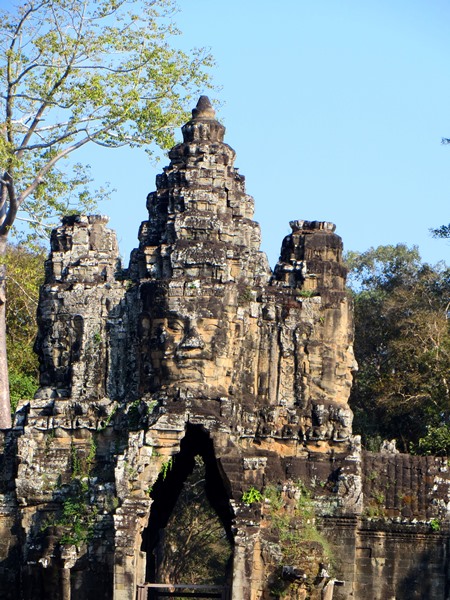Siem Reap And Angkor Wat
The Old Town of Siem Reap which straddles the tranquil Siem Reap River is a natural base for visitors who wish to explore Angkor. By day, its web of pedestrian streets sees a modest flow of tourists, while locals scurry through the market and go about their daily chores.

At night, the area comes alive with a party-like atmosphere. Barbecues are set up outside fish restaurants, and the smell of fresh barbecued fish wafts through the air. Open-fronted cafés and restaurants overflow with visitors; and the famous fish tanks attract an endless stream of customers who prop themselves on the edge of the tanks to experience the weird sensation of fish nibbling away at the dry skin on their feet, leaving their feet as smooth as those of a newborn baby.


From the fish tanks, one can stroll up the street to have an outdoor pedicure while relaxing –drink in hand – on a comfortable lounger and enjoying the balmy night air and the festive ambience. The fairy lights on the bridges sprinkle the waters below with a glitter of color, and the Night Market bustles with tourists browsing the stalls brimming with handmade Cambodian crafts and clothing.


Siem Reap has a smorgasbord of excellent hotels from large five-star resort hotels, to small boutique hotels, excellent budget hotels, and backpacker accommodation.



As the day dawns and darkness gives way to light, visitors flock to see the ancient city of Angkor bathed in the glow of the first rays of the sun.

We have all seen photos of spectacular Angkor Wat, however, while Angkor Wat is the largest and best preserved of all the temples, the ancient metropolis of Angkor once covered an area of more than three hundred and sixty-eight square miles and boasted more than one hundred temples. The temples were built by the Kings of Angkor – who were considered god-kings – to honor the Hindu gods: Brahman, Vishnu, and Shiva.

Pre Rup, which was dedicated to Shiva, is one of the oldest Hindu temples in the Angkor complex. It was built by King Rajendravarman in 961 atop a high tiered platform and is the last of the “Temple Mountains” to be built in Angkor. The temple’s name has led historians and archeologists to believe that it may have been used for funerals and cremation ceremonies. Climbing Pre Rup’s wall of steps rewards one with a fantastic view of Angkor.

In around the year 1200, Buddhism eclipsed Hinduism in Angkor so that in some cases (as in Angkor Thom built by King Jayavarman VII) one sees a blend of Buddhism and Hinduism, and in other instances, Hindu art, sculpture, and carvings were replaced by Buddhist images. King JayavaramVll reigned for thirty-nine years from 1181-1220 and was the most prolific builder. He built temples, hospitals, and rest houses. Angkor Thom, Ta Prohm, Ta Som, Neak Pean and Preah Khan – are among the spectacular structures built during his reign. Each one is unique and each one worth a visit.
Angkor Thom is both fascinating and immense in scale. Its defining pieces are massive stone carved faces found in groups of four. They look out into the distance with almond eyes, broad noses, large earlobes, elaborate headdresses, and thick smiling lips which have come to be known as ‘The Smile of Angkor.’


Ta Prohm is magnetic. It was built on one level with connecting passages, galleries, temples, and courtyards. It lay hidden for hundreds of years covered by the dense jungles. The giant, majestic, Spoong trees, wrapped their thick trunks and roots around this architectural jewel to create a unique and exquisite new form of art and sculpture.

Neak Pean lies in a forest and is set in a large manmade pond surrounded by four smaller ponds said to represent Water, Earth, Air, and Fire. Scholars and historians believe that a sick individual was directed to bathe in whichever pond was thought to be appropriate to heal their specific ailment. Neak Pean has an unforgettable aura of tranquility and spirituality.

Preah Khan surrounded by the dense jungle has a restful, romantic beauty. Covering a huge area of one hundred and thirty – eight acres, Prea Khan was a city surrounded by a moat. The temple is low and flat with a seemingly endless number of perfectly symmetrical galleries. In its day, Preah Khan functioned as a center of learning and a monastery.


Sunset over the Angkor temples inspires one with awe. The crowds have thinned out, the tones of the ancient stones deepen, and silence reigns save for the clicking chorus of the cicadas and chirping of birds.

